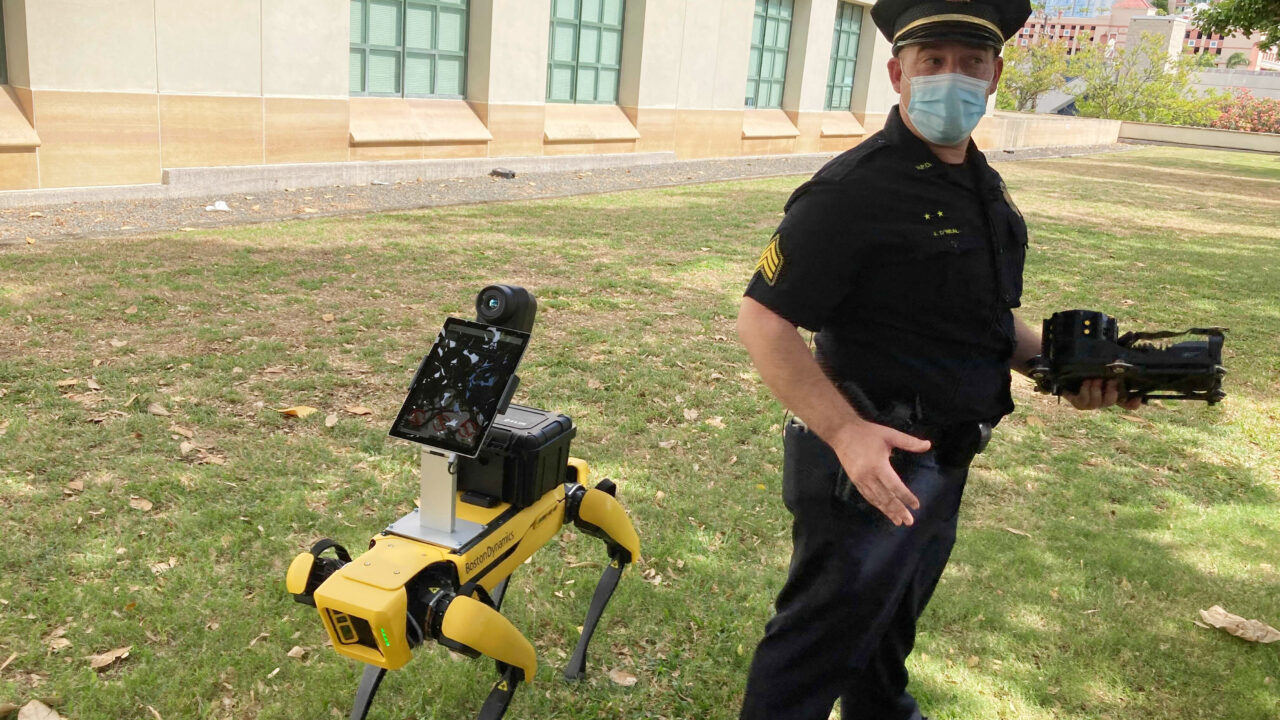Los Angeles Becomes Latest City to Approve Robot Dogs Despite Grave Concerns
It has been widely noted that these canine robots closely resemble those featured in a 2017 episode of the science fiction horror drama "Black Mirror." Honolulu Police Acting Lt. Joseph O'Neal demonstrates a robotic dog in Honolulu, Friday May 14, 2021. (Photo: Jennifer Sinco Kelleher/AP)
Honolulu Police Acting Lt. Joseph O'Neal demonstrates a robotic dog in Honolulu, Friday May 14, 2021. (Photo: Jennifer Sinco Kelleher/AP)
Los Angeles is the latest big city to introduce robot police dogs despite grave concerns about their safety. Each unit, designed to resemble a real dog’s scamper and occasionally aggressive crouch, will cost the city $278,000.
One wonders how many mental health professionals and treatment beds New York and San Francisco might have paid for with their robot dog budgets, and whether they might be better uses of public funds than bringing a “Black Mirror” episode to life.
“We’ve seen these robot dogs crop up in other police departments around the country, including New York and San Francisco, where the community is similarly fighting back against bringing this kind of depersonalized, military-style technology to municipal police forces,” City Councilwoman Eunisses Hernandez told CBS LA.
The machines, called Quadruped Unmanned Ground Vehicles, won’t be armed, but are built with the capacity to wield weapons. Earlier this year, the San Francisco City Counsel defeated a measure that would have armed the robo dogs, ensuring the technology’s ballistic capacity remains unused — for now. Washington D.C. unleashed the robot dogs in 2021, the Military Times reports.
In April, New York Mayor Eric Adams boasted about the machines’ capabilities after a metal dog was dispatched to a collapsed parking garage in lower Manhattan.
“Just one week ago, I was being criticized by all the folks in the bleachers, saying, ‘Well, why are you getting that dog?,'” Adams said. “Now you see why I got the dog — to save lives.”
The garage collapse killed the manager and five others were injured, and it’s not clear what role the dog played in the rescue effort. It’s also unclear why two dogs are being delivered to the New York Police Department, with its miles-long record of abuses, over the fire department. Though not a perfect organization, the Fire Department of New York has a much better human rights record than the police, and extensive training in dealing with situations like building-collapse rescues. The main concern is that the robot dogs will be deployed in poor communities and communities of color.
It has been widely noted that these canine robots closely resemble those featured in a 2017 episode of the science fiction horror drama “Black Mirror.” In that episode, titled “Metalhead,” the few remaining survivors of an unspecified apocalypse in Scotland are hunted by robot police dogs of incredible intelligence, strength and speed. (“Oh fucking hell — this is mental, this is,” says a character in the episode, of her robot dog pursuers.)
The prospect of fleets of robot dogs dominating a police-state dystopia, per “Black Mirror,” still feels (somewhat) far-fetched. But that doesn’t mean that they are without worrying near-term risks, or that they are a good idea at all. Modern U.S. police departments are notorious for mission-creep and militarization, as outlined by the journalist Radley Balko in “Rise of the Warrior Cop.”
Consider the origins of the SWAT team. Created in response to a 1966 lone gunman in Austin, Texas, SWAT units proliferated throughout the country and have become infamous for no-knock raids, including in nonviolent drug cases. The historical trajectories of U.S. policing make it all too easy to imagine robot dogs becoming terrifying and counterproductive features of no-knock raids in the middle of the night.
It is equally difficult to imagine the benefit in the case of raids on homeless encampments populated by people with mental illnesses. A device that has already inspired a literal sci-fi horror show may not be the best way to calm someone having a psychotic break. One wonders how many mental health professionals and treatment beds New York and San Francisco might have paid for with their robot dog budgets, and whether they might be better uses of public funds than bringing a “Black Mirror” episode to life. Los Angeles’s Skid Row is a massive homeless encampment, filled with many people who have serious mental and physical health problems. It begs the question: does Los Angeles need a $278,000 robot dog? Or health resources for its most vulnerable people?
Your support matters…Independent journalism is under threat and overshadowed by heavily funded mainstream media.
You can help level the playing field. Become a member.
Your tax-deductible contribution keeps us digging beneath the headlines to give you thought-provoking, investigative reporting and analysis that unearths what's really happening- without compromise.
Give today to support our courageous, independent journalists.






You need to be a supporter to comment.
There are currently no responses to this article.
Be the first to respond.